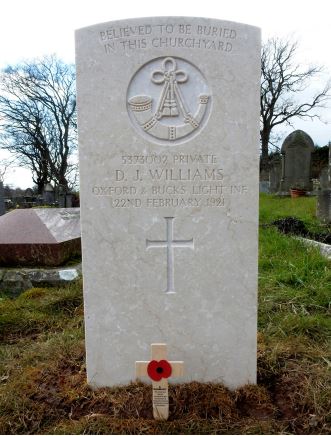1st Battalion, Oxfordshire & Buckinghamshire Light Infantry

David John Williams was born in Cinderford, Gloucestershire on 25 June 1887, son of David Williams (1843-1916), a colliery carpenter and wheelwright, and Isabella (formerly Meredith) (about 1846-1937). By 1901 the family had moved to Joys Green, near Lydbrook where he and his father were both employed locally in colliery work.
On 25 July 1905 he attested, at Coleford for service with the Gloucestershire Regiment being first posted to the 2nd Battalion at Warley, Essex and was allocated the number 7996. In February 1908 he was posted to the 1st Battalion serving in India. The 1st Battalion returned from India in October 1910 but en-route he was posted to the 2nd Battalion which was garrisoned in Malta where he served until April 1913 when he was discharged to Army Reserve (Class B).
Returning to the Forest he married, in April 1914, Fanny Louisa Hughes (born 1894) of Upper Oldcroft, near Lydney. There was one daughter of the marriage who died in infancy.
As a Reservist he was mobilized on the outbreak of war and on 27 August 1914 he landed in France for posting to the 1st Battalion, Gloucestershire Regiment. He took part in the actions of the retreat from Mons and in the First Battle of Ypres, being wounded in the left hand on 29 October 1914. As a result he was invalided back to the UK for treatment before discharge to the Depot at Horfield Barracks, Bristol.
Returning to the Forest he married, in April 1914, Fanny Louisa Hughes (born 1894) of Upper Oldcroft, near Lydney. There was one daughter of the marriage who died in infancy.
As a Reservist he was mobilized on the outbreak of war and on 27 August 1914 he landed in France for posting to the 1st Battalion, Gloucestershire Regiment. He took part in the actions of the Retreat from Mons and in the First Battle of Ypres, being wounded in the left hand on 29 October 1914. As a result he was invalided back to the UK for treatment before discharge to the Depot at Horfield Barracks, Bristol.
Whilst at the Depot he deserted, in early January 1915, presumably returning to his home (his daughter having been born on 26 December 1914). He returned in June, whereupon he was tried by District Court Martial, found guilty and sentenced to 112 days imprisonment with hard labour. The unexpired sentence was later remitted and he was posted to the 7th Battalion in Gallipoli, arriving there in late October 1915. He suffered frostbite whilst on the Peninsula. When the battalion was evacuated to Egypt he was returned to the Depot at Bristol from where he was next posted, in March 1916, to the 10th Battalion at Bethune. The 10th Battalion was moved to the Somme on 4 July 1916 and a week later at Contalmaison he was badly wounded and evacuated to the UK and treatment at 3rd Western General Hospital in Cardiff.
After recovering he was posted to the 3rd Battalion at Bristol. In January 1917 he was discharged as physically unfit for further service. He was called to a Medical Board in April 1917 which assessed him to be sufficiently recovered to be placed on Army Reserve (Class P). After a short time on the Reserve he was again mobilized but to the Oxfordshire and Buckinghamshire Light Infantry as Private 50493 serving with his new regiment until the Armistice after which he was discharged.
Returning servicemen found employment difficult to find after the war and it is believed to be because of this that on 4 December 1919 he re-enlisted with the Oxfordshire and Buckinghamshire Light Infantry and (with a new number – 5373002) was posted to the 1st Battalion stationed at Limerick in early 1920. The so-called Irish War of Independence became most intense into 1921 and on 13 February three soldiers, amongst them Private Williams, went missing from Strand Barracks in Limerick. On 22 February 1921 a farmer found the bodies of the three in a field at Woodford, County Galway, murdered by the IRA or Sinn Feiners as they were referred to at the time.
The remains of 33-year-old Private David John Williams were returned to England and interred, with Military Honours in Viney Hill (All Saints) Churchyard on 28 February 1921. There he lay in a unmarked grave until 2010 when a local researcher found the report of his funeral in the local newspaper. The Commonwealth War Graves Commission had commemorated his death but his place of burial was not officially recognised. A case was put to the Commission which was accepted and he is now remembered in the churchyard by a CWGC Special Memorial beside the path leading to the door of the Church.
Researched by Eric Nicholls February 2021
